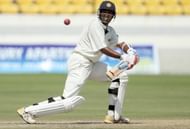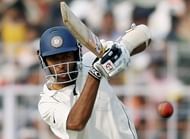It was a quarter-final match of the Giles Shield – a premier school level tournament of Mumbai. The year was 1993. Anjuman Islam Urdu’s opener threw away his wicket while batting on 77. His brother slapped him for playing a reckless shot and got frustrated with his younger brother’s batting failure. His dismissal resulted in Kendriya Vidyalaya enforcing the follow-on. The determined Anjuman Islam opener batted for a day and a half in the second essay and compiled a monumental 400. Kalim Jaffer’s slap taught Wasim an important lesson in cricket – “Never throw away your wicket after getting a start.”
After twenty years, Jaffer has acquired a legendary status in domestic cricket. But life was never easy for the stylish opener. Breaking into Mumbai under-16 side is an onerous task. Jaffer could not find a place in the U-16 side despite scoring a lot of centuries – and by centuries, I mean big centuries at the school level. The rejection faced by Jaffer during that phase made him sad and depressed. He cried inconsolably. Jaffer soon understood that his ascent to the top-level would always be obscured by difficulties. Life is not a bed of roses, and he had to endure pain and rejection, and yet emerge victorious. The fighter in Jaffer came to the fore during the Shatkar Trophy – an under-16 selection trial tournament. Jaffer scored a patient 206 not out, and now the ball was in the selection panel’s court. Sudhir Naik, a former Test batsman, was the head of the selection panel. He wasted no time in not only including Jaffer in the under-16 side, but also asked him to be a part of National Cricket Club (NCC). The club was an ‘A’ division club and certainly one of the finest maidaan clubs in Mumbai.
Jaffer hailed from a very humble background. His father was driving BEST buses [the government buses that run within Mumbai]. Jaffer’s father couldn’t afford a personal cricket kit for his son. Jaffer used to use the facilities provided by his school – bats, gloves and pads. After his selection in the Mumbai under-16 side, Jaffer got sponsors.
Jaffer was not a part of the playing XI immediately. He was managing the scoreboard and observing the nuances of batting from his peers. When his turn came to bat for NCC, Jaffer scored heavily in the club matches. There was a general belief around the maidaans that if you couldn’t get Jaffer within the first twenty minutes, then you’d have to be prepared for leather chasing for the entire day. He was a ‘khadoos’ batsman [one who does not easily throw away his wicket]. Jaffer hardly gave the opposition an inch. He was immediately selected in the Mumbai under-19 team.
Jaffer played cricket non-stop. When he came back from the U-16 and U-19 tours, he always found time to participate in the Purshottam Shield or Talim Shield, premier club level competitions in Mumbai.
In 1996, Jaffer was included in the Ranji Trophy team due to the sheer weight of his performances in club and U-19 cricket. On the 27th October, 1996, Jaffer walked alongside Mumbai skipper Sanjay Manjrekar to open the innings against Gujarat. Jaffer failed to impress on his debut, scoring only 11. Mumbai inflicted an innings defeat on Gujarat and headed to Rajkot to face Saurashtra.
Saurashtra won the toss and batted first on a placid track. Saurashtra batted for two days and scored 595 for four, with Sudhir Tanna, Bimal Jadeja, Prakash Bhatt and Hitesh Parasana scoring hundreds. Mumbai captain Sanjay Manjrekar was asked to join the Indian team for the finals of the Titan cup on short notice. Jaffer therefore had to open the innings with wicket-keeper Sulakshan Kulkarni. Jaffer found his pristine touch. He was batting with extreme ease. The first wicket partnership of 459 broke Saurashtra’s spirits. Kulkarni got out on 239, but Jaffer was still batting.
Jaffer batted for 675 minutes and made his first triple century at the age of 18. His 314 not out helped Mumbai overhaul Saurashtra’s total. Mumbai scored 647 for four. The triple-hundred helped 18-year old Jaffer cement his place in the Mumbai side and the annals of Indian cricket.
209 first class games later, Jaffer remains the most celebrated domestic cricketer in India. He has 32 Ranji Trophy hundreds, 9155 Ranji Trophy runs and has never lost a game for Mumbai as a captain. At 34, Jaffer is playing the best cricket of his life. He could do no wrong, and has a Bradmansque average at the domestic level, to prove that age is just a number.
As the Irani Trophy ended, everybody shook Jaffer’s hand after he scored yet another ‘routine’ hundred. Yet, he missed the India selection. Be rest assured, Jaffer will come back in the next season with his free-flowing shots, water-tight defence and hunger for runs. He is a wounded soldier.
Beware domestic bowlers, Jaffer is coming.
Brand-new app in a brand-new avatar! Download CricRocket for fast cricket scores, rocket flicks, super notifications and much more! 🚀☄️


